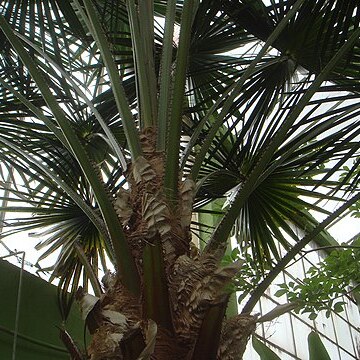Trunk to 12 m tall, 15–25 cm diam., grey; base with persistent petiole stubs, smooth above. Leaves 25–35 in a rounded crown, rigidly radiating; petiole 70–100 cm long, 14–20 mm wide, with curved thorns on proximal margins; leaf blade circular, 60–90 cm long, flat, chartaceous, olive-green to grey-green adaxially, dull bluish green abaxially, glabrous except for a few scales on ribs, divided for c. 1/2 its length; segments 48–60, rigid, shortly bifurcate, with acute lobes. Inflorescence 80–160 cm long, branched to 4 orders; bracts striate, with silver scales; rachillae minutely papillose, maroon. Flowers solitary or in sympodial clusters of 2 or 3, campanulate; sepals maroon, broadly triangular, 0.8–1 mm long, cuspidate, fleshy; petals yellow, ovate, 1.3–1.6 mm long, subacute; stamens c. 1.4 mm long. Fruit ellipsoid, 10–12 mm long, bluish black to reddish black, pruinose. Seed globose, 8–9 mm long.
More
A fan palm. It is a sturdy palm. It grows to 12-20 m high. It is often smaller. The trunk is 25 cm across. The trunk has rings of old leaf base scars. The crown is dense. The leaves are stiff and dark green. The leaf stalks are 1 m long. The leaves are circular and flat. The flowers are dull yellow on a dense flower arrangement that is in the centre of the crown. The fruit are oval and 1.5 cm long. They are deep brown to black.

